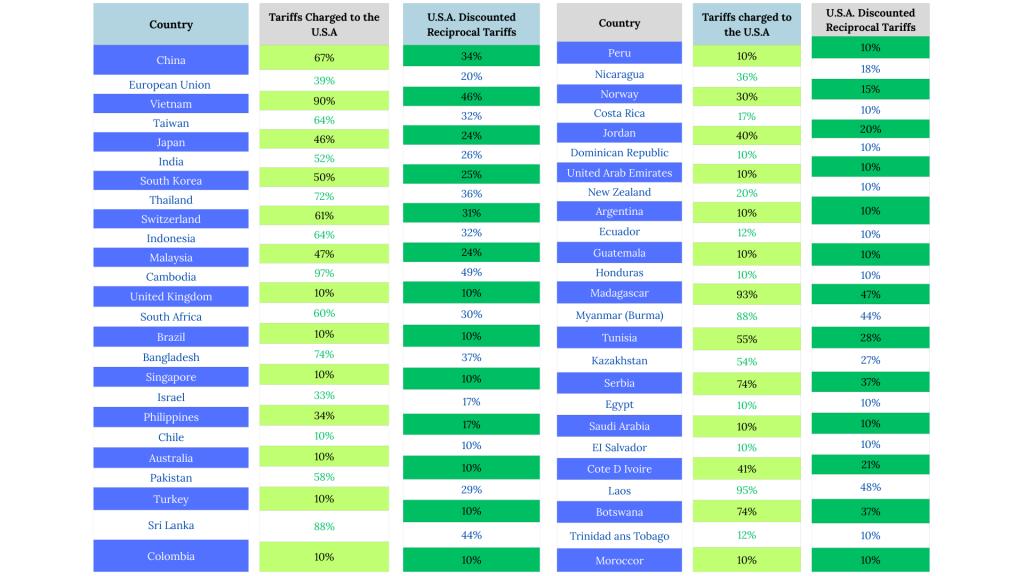Reciprocal US Tariffs 2025: Impact on India’s Export Trade
When Trump secured a historic victory in the US Presidential Elections in 2024, the Global Financial market expected a big shuffle, and Reciprocal Tariffs were one of them. The newly elected US President Donald Trump announced Reciprocal Tariffs on April 2nd, 2025, on more than 50+ countries worldwide. Let’s dive deep into the impact of reciprocal tariffs on India’s export trade with the US & how they impact the Indian economy.
What are Reciprocal Tariffs?
Reciprocal Tariffs refer to the taxes that are imposed by a country on another as a retaliatory step. In simple language, suppose country A charges a 20% tax on imports from country B, then in reciprocal tariffs, country B would do the same and charge similar or higher tariffs on the imports of country A.
To ensure fair trade practices, the imposition of reciprocal tariffs is one of the most important moves. The US tariffs signal that it will no longer tolerate any exploitative or unbalanced trade policies even with emerging countries.
The reciprocal tariffs aim to protect local industries and the job market while adapting to protectionism. One such move taken by the US is the imposition of a 26% tariff on Indian imports, which has several implications for the emerging Indian economy.

Tariffs on BRICS Countries
As per the estimates shared by economists, the impact of tariffs on Indian exports to the US is bearable by the businesses as compared to their Asian and European competitors. Most Asian countries, like China, Japan, India, and others, have witnessed higher counter-tariffs from the US.
The US paid particular attention to the BRICS countries when it was time to impose reciprocal tariffs. China, India, and South Africa have seen a significant discount on US imports. China sees a significant discount with lowered tariffs to 34% from 67% for US imports. similarly , South Africa discounted to 30% from 60% and India to 26% from 52% on the imports.
India’s Export & Reciprocal Tariffs
- In the Financial Year 2023-24, the total merchandise exports to the US accounted for 18% and were valued at approximately $ 79 B
- The US is one of the largest export destinations for India, and the 18% comprises a variety of sectors like engineering goods, electronics, gems and jewellery, textiles, automobiles, pharmaceuticals, among others
Engineering Goods
- Some of the engineering goods are machinery, electrical equipment, and steel products exported to the US
- Of the total 18% exports to the US, about 22% comprises engineering goods, and tariffs impose a 25% duty on steel and aluminium, increasing the cost for Indian exporters
- As compared to domestic consumption, limited exposure to steel may reduce the impact
Electronics
- This sector makes up 13% of the total exports to the US (of 18% of the total Indian exports)
- Reciprocal tariffs of 27% will raise the cost, but still the competitors have felt a sharper blow, China facing 54% and Vietnam 46%
Pharmaceuticals
- Contributing to 10% of the 18% total Indian exports to the US, the pharmaceutical industry is exempt from the reciprocal tariffs and could see exponential growth as compared to its competitors. India has negotiated a fair deal with the US.
Automobiles and Auto Parts
Automobiles and auto parts make up for 3% of total Indian exports to the US and contribute to $2.6 billion. The US imposes reciprocal tariffs of 25% on automobiles and parts. However, the impact would be negligible as the exports in this sector are limited.
Other Sectors
This sector makes up 29% of the total Indian exports to the US and includes products like petroleum, chemicals, and cereals. Some of these products, like oil and gas, are exempt from tariffs, while 27% tariffs are imposed on others.
It could be concluded that the reciprocal tariffs are not likely to affect Indian exporters as the effect would be limited. Due to limited exposure to automobiles and parts in the US market, a small portion of the total exports would be affected.
- Pharmaceuticals are exempted, and the textiles are likely to gain due to higher tariffs on competitors like Bangladesh and China. Though the engineering goods and gems industry may face challenges but they can dive into other diverse markets.
- Ongoing trade negotiations with the US may even further reduce the impact of tariffs.
Get started with TaxDunia to know more about the reciprocal US tariffs and how they can impact your business.

